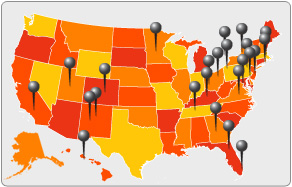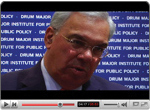Mayor TV is a challenge from America’s mayors to the 2008 Presidential candidates: Start talking about cities. Learn more
- Mayor Christopher A. Doherty
- Scranton, PA / Pop. 72,861 / Elected 2001
-
“The strength of a city is the combustion engineering that takes place inside it.”
— Mayor Christopher A. Doherty

- Mayors We Interviewed
-
-
Antonio Villaraigosa
Los Angeles, CA

“Poverty, work and opportunity, bolstering the middle class, housing, infrastructure ... it is absolutely criminal that the federal government has failed to address these issues.”
-
Shirley Franklin
Atlanta, GA

“We must invest in infrastructure, or Atlanta's economy -- and the national economy -- is going to shrivel up and die.”
-
Manny Diaz
Miami, FL

“The media and the pollsters focus on issues like war, abortion, gay rights. Quite frankly, for those of us in the trenches, they're not the hot button issues.”
-
John Hickenlooper
Denver, CO

“Cities are America's laboratories. But once we figure out solutions, we need the federal government's help to roll them out to the entire country.”
-
R.T. Rybak
Minneapolis, MN

“I want a community organizer in the White House, because that's what I do every single day.”
-
Douglas Palmer
Trenton, NJ

“Our cities are where it’s at.”
-
Christopher Doherty
Scranton, PA

“The strength of a city is the combustion engineering that takes place inside it.”
-
Pegeen Hanrahan
Gainesville, FL

“Use our cities more effectively.”
-
Byron Brown
Buffalo, NY

“The presidential nomination process certainly has a negative effect on the coverage of cities.”
-
Tom Menino
Boston, MA

“I challenge you, presidential candidates - talk more about cities. It will be beneficial to you, it will be beneficial to the country.”
-
Rocky Anderson
Salt Lake City, UT

“President Bush has not only neglected cities, but has hurt our cities in such enormous ways.”
-
Sheila Dixon
Baltimore, MD

“We have wars here in our city. We should be making strides against drugs and gang violence, but it's something I never hear the presidential candidates talk about.”
-
Bob Duffy
Rochester, NY

“Our cities across this country are proud. They have a great history. But like a boxer, they've taken one knee, and they have to bring themselves back.”
-
Antonio Villaraigosa
- More About:
- The Nation
- Drum Major Institute
Alon Levy on 04.21.08
Sure cities are coming back - just not Scranton. The Northeast has three productive city regions: New York, Philadelphia, and Boston. Washington and Baltimore look productive, but actually live off of federal subsidies. For example, the New York CSA paid $93 billion in taxes more than it got back in spending in 2004. For the Washington-Baltimore CSA, it was $67 billion in the other direction.
Outside New York and Chicago, the cities that are coming back in the US tend to be suburbs. Washington D.C. keeps losing population; the growth is in the edge cities in Arlington and Fairfax County. Philadelphia proper is more like Brooklyn than like Manhattan in its importance to the region.
That's why I like the program espoused by the Mayors of Trenton and Jersey City... it comes off as something that could promote real deslumming and prevent sprawl, as opposed to gentrification, which merely relocates the problem elsewhere.
Harry Moroz on 04.21.08
Thanks for the comment, Alon.
Despite its past struggles (which include being declared a "distressed city"), Scranton remains an important city in Pennsylvania. Scranton generates the sixth largest share of GDP in the state and contains the fifth largest share of the state's jobs (4.5%). That said, Scranton's population, as measured by the Census Bureau has continued to decrease. However, arrival of Hispanic immigrants to Scranton might have mitigated some of these population losses and Mayor Doherty told us that he expects the Hispanic population to rise to as much as 20% of Scranton's total. Scranton can quite plausibly be thought of as a suburb of New York City. (See here for a Brookings report on Pennsylvania's cities.)
I think that your points, as well as Mayor Doherty's, demonstrate the need for a broader discussion of urban issues. The question remains: how do we encourage policymakers to focus on cities - including medium-sized ones and especially postindustrial ones - as solutions to problems associated with climate change, globalization, and economic ferment. Scranton has benefited from outside investment and from its own investment in infrastructure; that is to say, the city is not "going away" any time soon. So, how do we encourage Scranton to be (or become) an economically, demographically, and environmentally stable suburb of New York City?
Alon Levy on 04.21.08
I don't think Scranton is yet a suburb of New York. Lackawanna County's commuting ties with the New York metro area are weak. The Census Bureau has a data sheet about commuting ties between each pair of counties. Lackawanna County had 94,532 commuters in 2000; of these, 642, or 0.68%, work in the New York MSA. That's not much stronger a commute tie than Connecticut's Hartford County's to New York; if Fairfield County were included in the New York MSA, Hartford County would have a stronger commute tie.
Although the exurbs of New York are beginning to encroach on Scranton's suburbs, there's little chance Scranton will ever become a suburb of New York. The distance between the two cities is 200 kilometers, which even without traffic is too long for a car commute. The range of a rail commute is very short: the Tokyo metro area, which is based entirely on heavy rail, extends about 50 kilometers from its central ward, Chiyoda. 50 kilometers from Lower Manhattan gets you about as far as Hicksville, White Plains, Edison, and Morristown. Beyond that distance, taking the train is possible, but the commute will become too long to be feasible.
Besides, don't we want people living closer to where they work rather than farther away?
Fed-up on 07.14.08
Illegal immigration hurts the city of Scranton. It gives jobs to illegals instead of U.S. citizens and these jobs Americans will do. construction,warehouse jobs, cleaning jobs,who did these jobs before the illegals high school kids college kids,older people can't afford to stop working,woman who can only work part time.Scranton is starting to displace it's people(You know the ones who pay your salary) You have turned this city in a sanctuary city the price is high i hope you will be ready for the faud, and gangs. When people of Scranton are losing their jobs to the illegals the price will be higher. The lose of your job.